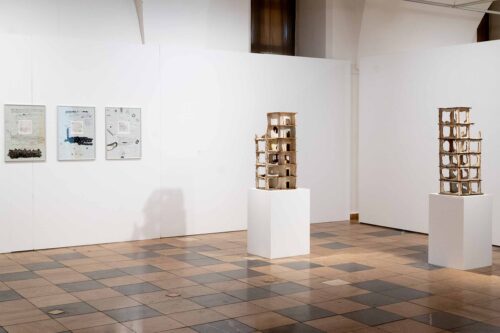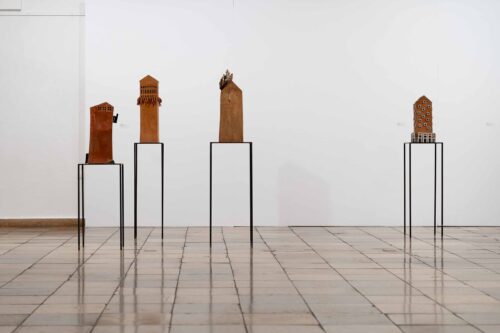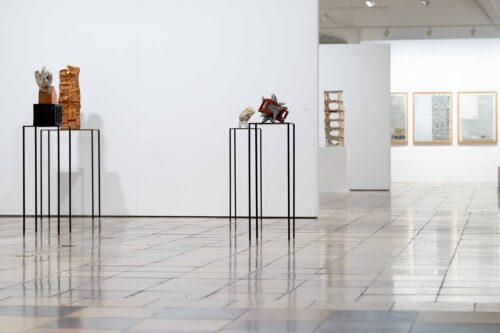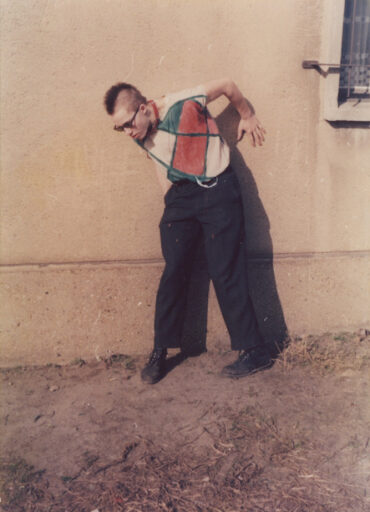
zu/haus – bei sich Rachel Kohn & Christiane Wartenberg

Rachel Kohn, Was bleibt II, 2022, Steinzeug, Ausschnitt & Christiane Wartenberg, Zitat aus R. M. Rilke „Die Aufzeichnungen des Malte Laurids Brigge“, 2022, Wortbild, Ausschnitt, Collage, 2024 © Rachel Kohn & Christiane Wartenberg
Ihr Interesse gilt dabei architektonisch anmutenden Objekten, die beizeiten alsEinzelformen, jedoch häufig als variable Ensembles mit installativem Charakter gezeigt werden. Jenseits der geradezu klassischen Arbeit mit dem formbaren, anorganischen Naturmaterial experimentieren beide Künstlerinnen auf mannigfaltige Weisen mit jenem Werkstoffspektrum und entwickeln dadurch jeweils spezifische Formensprachen. Schnittstellen liegen vor allem in den unterschiedlichen Auseinandersetzungen mit Themen wie Verortung des menschlichen Subjektes durch architektonisch anmutende Gebilde, Behausung(-en) und Natur sowie der Fragilität von menschlicher Existenz.
Das Werk von Rachel Kohn (geb. 1962 in Prag, lebt und arbeitet in Berlin) kreist vielfach um die menschliche Sehnsucht nach Stabilität und Schutz versprechenden Verortungen, dem Daheimsein, dem Ankommen und dem Zurückkommen, oft aber auch dem Weggehen. Jenes Weggehen, das beizeiten auch ein Verlassen (werden) oder eine Flucht bedeuten kann, ist unweigerlich an soziale, oft auch an politische Bedingungen geknüpft und wird begleitet (oder motiviert) durch Unsicherheit und Instabilität. Jedes Objekt scheint eine spezifische Geschichte zu erzählen, dessen Ende (meist) offen bleibt. Die als geradezu psychologische Zustandsbeschreibungen lesbaren Arbeiten von Rachel Kohn lassen sich in verschiedene Gruppen einteilen: in einer intakten Gegenständlichkeit modellierte glasierte oder unglasierte Häuser, kaputte Behausungen, deren ruinöser Zustand das Resultat eines kalkulierten Umgangs mit dem getrockneten, ungebrannten, ins Wasser gestellten Tonobjektes ist, sowie textil anmutende Alltagsrelikte.
Das fragile Konstrukt von poetischer Imagination, Geschichte und Wirklichkeit als Matrix des Daseins, das ein ständiges Ausloten individueller sowie kollektiver Positionsbestimmungen erfordert, ist eines der wesentlichen Themen im Œuvre von Christiane Wartenberg (geb. 1948 in Magdeburg, lebt und arbeitet im Oderbruch). Ihre hausartigen Gebilde aus Ton ebenso wie die verschiedenen zweidimensionalen Bildträgermaterialien – seien diese nun recycelte Landwirtschaftsfolie oder Papier – tragen feine, jedoch deutliche Spuren der eigenen Geschichte, indem sowohl Gebrauchsspuren als auch Spuren des künstlerischen und handwerklichen Herstellungsprozesses sichtbar sind. Verwoben werden jene Verweise auf den menschlichen Körper mit Sprache/(Hand-)Schrift, die zu Textbildern werden sowie abstrakt-gestischen Zeichnungsfragmenten. So entstehen vielschichtige Gespinste und Strukturen, die auf (Denk-)Räume verweisen, darauf reagieren und auch herstellen. Die taktilen Oberflächen ebenso wie das zeichenhafte, beizeiten fast unsicher suchend wirkende der Schrift(-bilder) legen das vorsichtige Herantasten der Künstlerin an Themen und Formen gleichermaßen offen.
…
The exhibition links old and new works by two artists whose artistic positions are deeply rooted in sculpture. Both Rachel Kohn and Christiane Wartenberg favor ceramic materials, especially clay. Their interest lies in architectural-looking objects, which are sometimes shown as individual forms, but often as variable ensembles with an installation character. Beyond the almost classic work with the malleable, inorganic natural material, both artists experiment with this range of materials in a variety of ways and thus develop specific formal languages. Interfaces lie primarily in the different examinations of topics such as the location of the human subject through architectural-looking structures, housing(s) and nature, as well as the fragility of human existence.
The work of Rachel Kohn (born 1962 in Prague, lives and works in Berlin) often revolves around the human longing for stability and locations that promise protection, being at home, arriving and returning, but often also leaving. This departure, which can also mean leaving or fleeing, is inevitably linked to social and often political conditions and is accompanied (or motivated) by uncertainty and instability. Each object seems to tell a specific story, the end of which (usually) remains open. Rachel Kohn’s works, which can be read as almost psychological descriptions of states, can be divided into different groups: glazed or unglazed houses modeled in an intact objectivity, broken dwellings whose ruinous state is the result of calculated handling of the dried, unfired clay object placed in water, and everyday relics that appear to be textiles.
The fragile construct of poetic imagination, history and reality as a matrix of existence, which requires a constant exploration of individual and collective positioning, is one of the key themes in the oeuvre of Christiane Wartenberg (born 1948 in Magdeburg, lives and works in the Oderbruch). Her house-like structures made of clay as well as the various two-dimensional image carrier materials – be they recycled agricultural foil or paper – bear subtle but clear traces of their own history, as both signs of use and traces of the artistic and artisanal production process are visible. These references to the human body are interwoven with language/(hand)writing, which become text images as well as abstract-gestural drawing fragments. This creates multi-layered webs and structures that refer to (thinking) spaces, react to them and also create them. The tactile surfaces as well as the symbolic, at times almost uncertainly searching appearance of the writing (images) reveal the artist’s cautious approach to themes and forms.
















